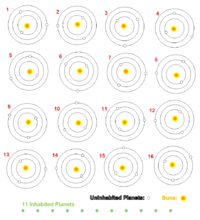Thank you Highlander. I think I'm getting mixed up trying to think about complementation and probability together. I have 16 triple planet systems. I find that I have 11 inhabited planets. I don't know whether the 11 planets are from 1 system each, or whether some of the systems have more than 1 inhabited planet. But I just want to work out the probability of the latter scenario. Therefore I first need to work out the first part - that the 11 planets are from 1 system each, and by subtracting that probability from 1, it will give me the probability of the second scenario. In a nutshell, is that the approach?
So first I work out the probability that 11 inhabited planets belong to individual systems. But there are 16 systems, from which any combination of 11 planets could be chosen. So first I work out how many combinations that could represent (16C11). Then imaginarily, each of those possible combinations of triple systems has 1 inhabited planet in it. So what is the probability of that? So it is a third per system. So then the probability would be a third times by 16C11. So the probability of more than one planet being inhabited is 1 minus a third multiplied by itself 16C11 times, which makes it highly probable that the 11 inhabited planets woud come from more than one planet per system.
So first I work out the probability that 11 inhabited planets belong to individual systems. But there are 16 systems, from which any combination of 11 planets could be chosen. So first I work out how many combinations that could represent (16C11). Then imaginarily, each of those possible combinations of triple systems has 1 inhabited planet in it. So what is the probability of that? So it is a third per system. So then the probability would be a third times by 16C11. So the probability of more than one planet being inhabited is 1 minus a third multiplied by itself 16C11 times, which makes it highly probable that the 11 inhabited planets woud come from more than one planet per system.


